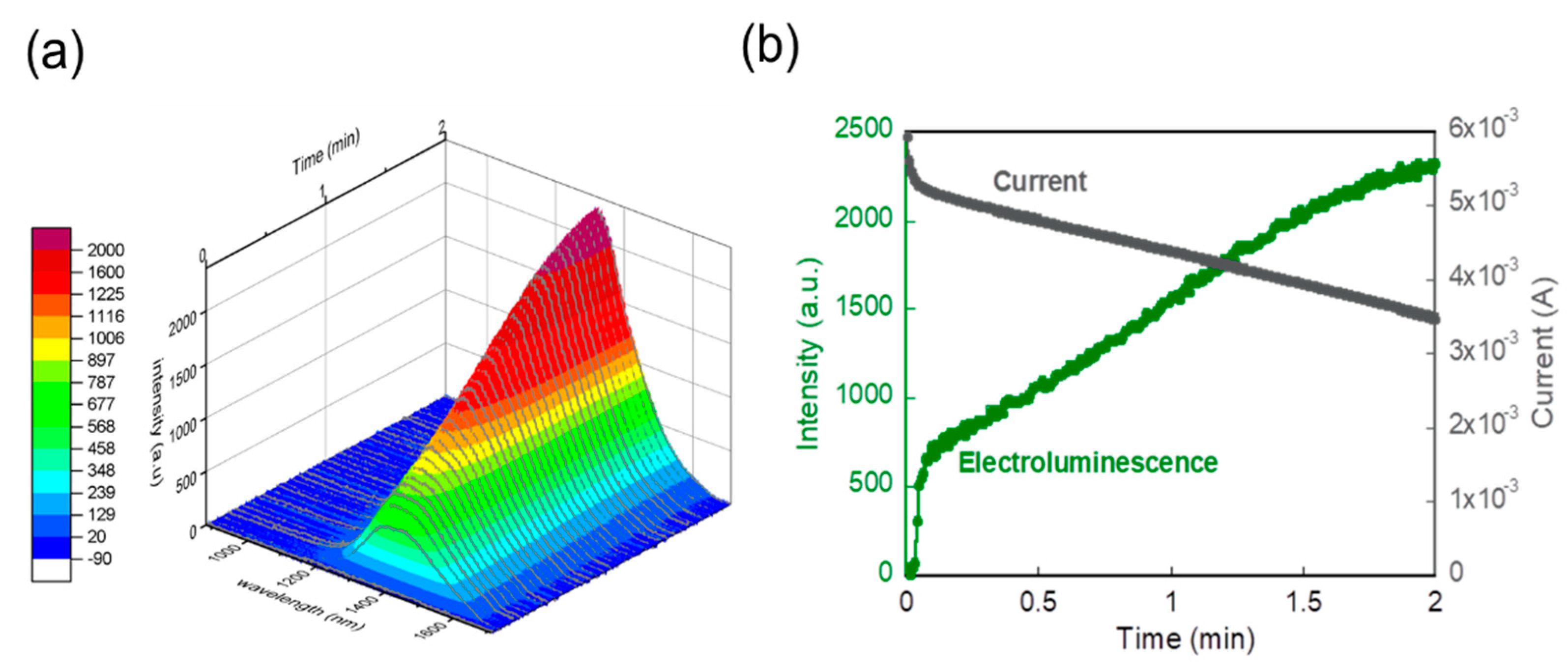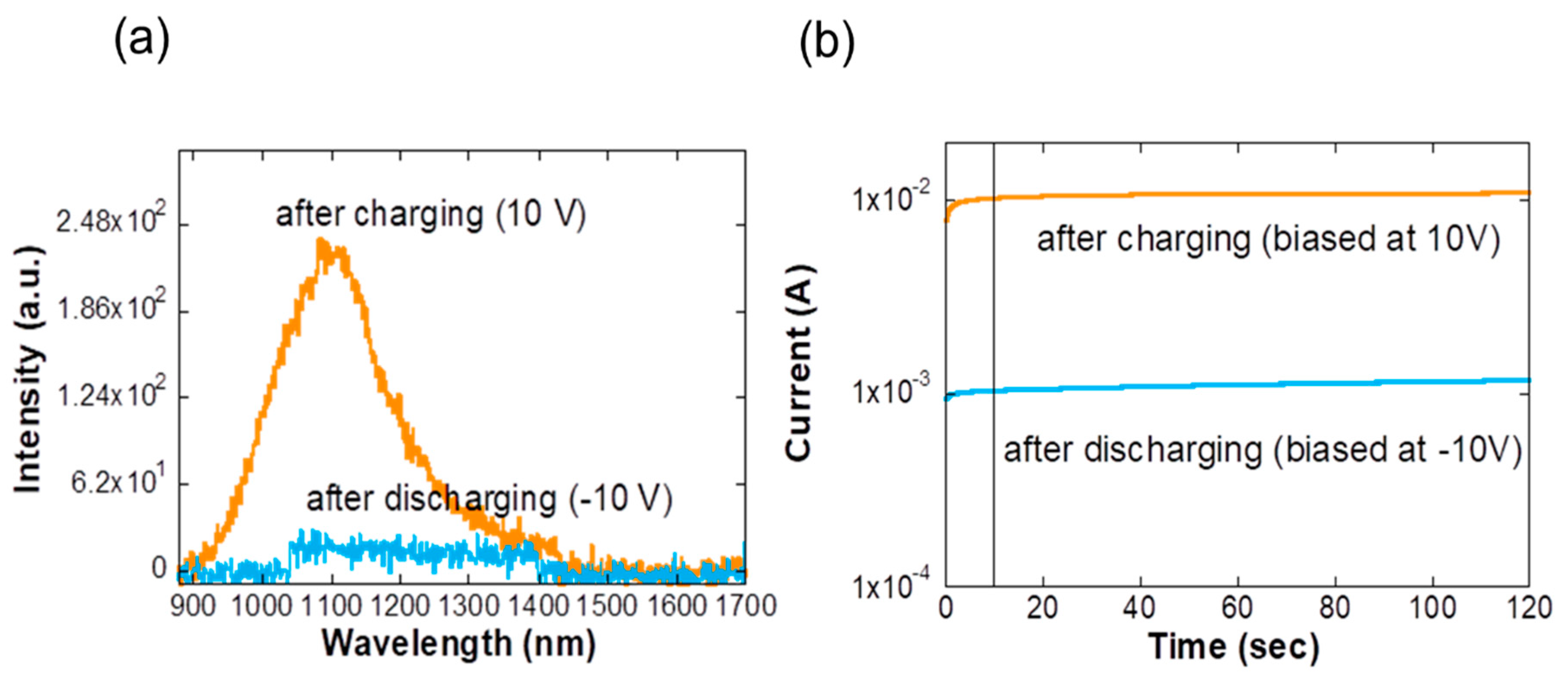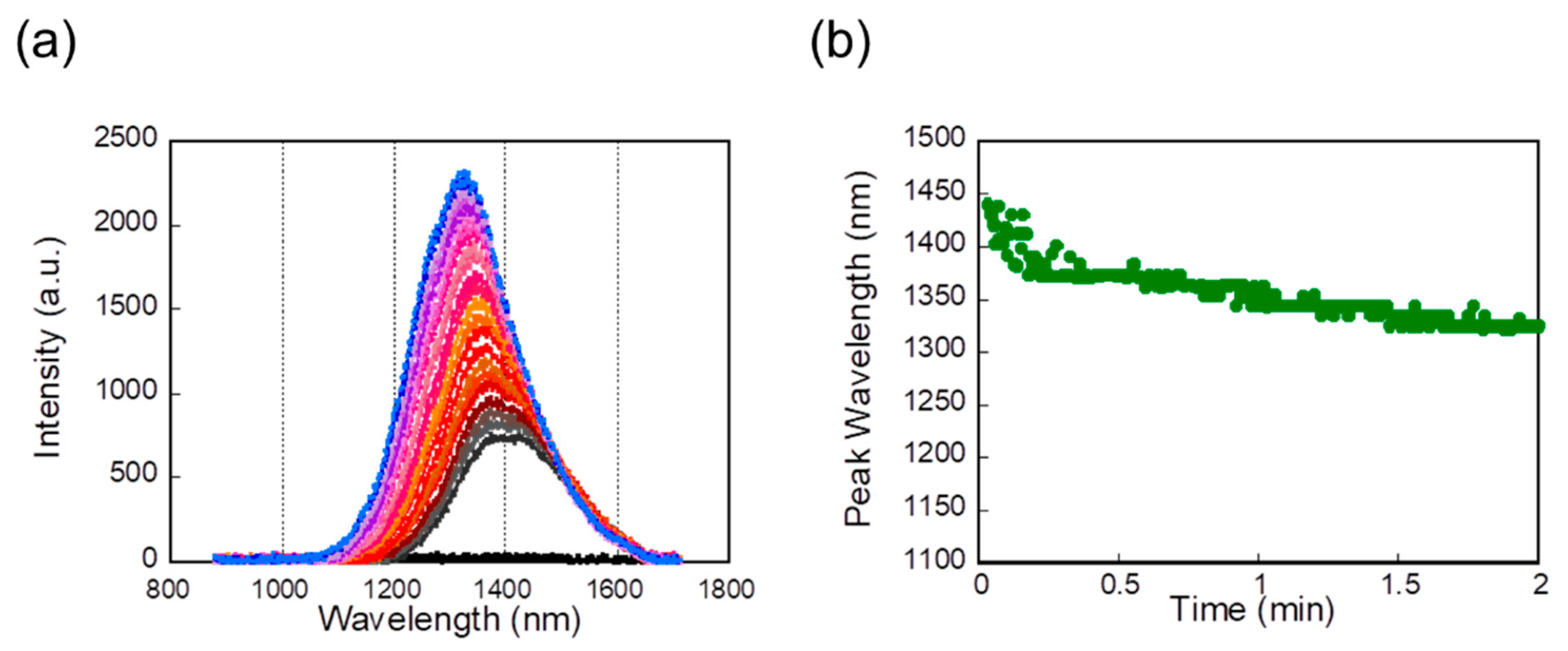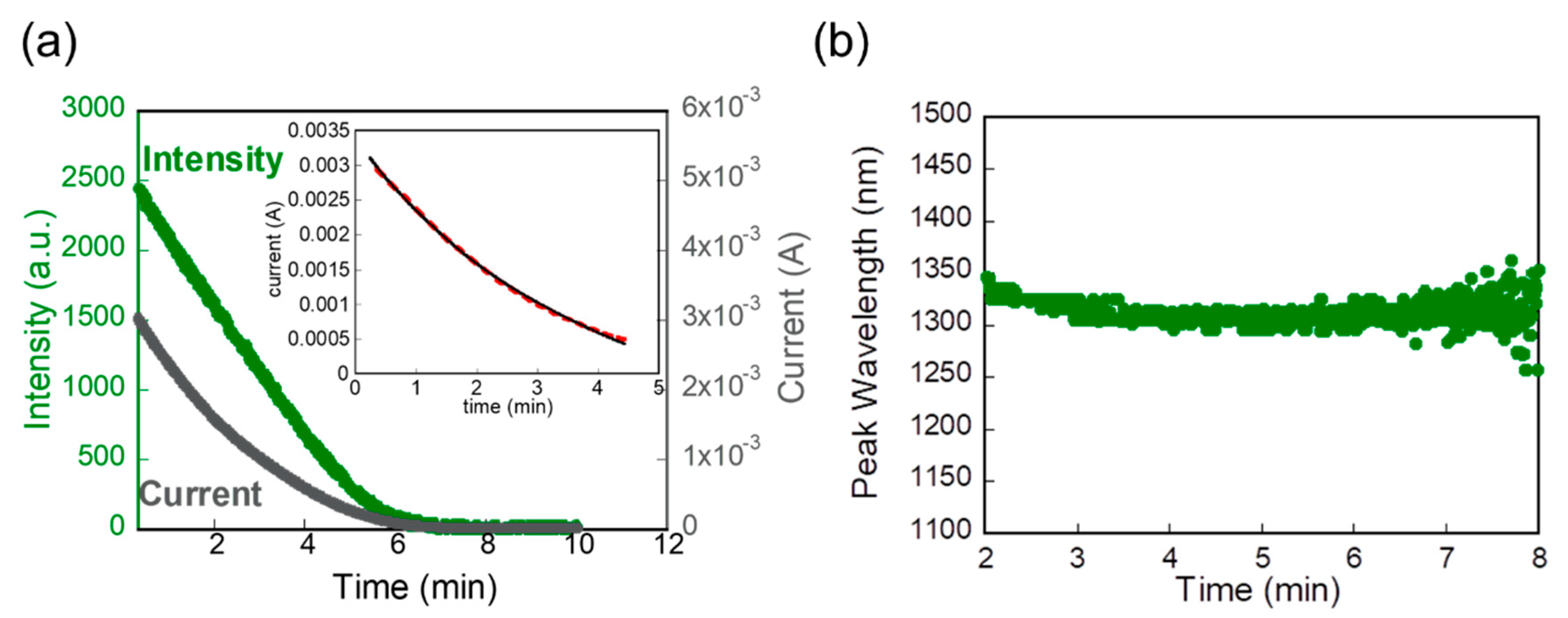Understanding Temporal Evolution of Electroluminescence Intensity in Lead Sulfide (PbS) Colloidal Quantum Dot Infrared Light-Emitting Diodes
Abstract
:1. Introduction
2. Materials and Methods
3. Results and Discussion
4. Conclusions
Author Contributions
Funding
Conflicts of Interest
References
- Caruge, J.; Halpert, J.E.; Wood, V.; Bulović, V.; Bawendi, M. Colloidal quantum-dot light-emitting diodes with metal-oxide charge transport layers. Nat. Photonics 2008, 2, 247–250. [Google Scholar] [CrossRef]
- Shirasaki, Y.; Supran, G.J.; Bawendi, M.G.; Bulović, V. Emergence of colloidal quantum-dot light-emitting technologies. Nat. Photonics 2013, 7, 13–23. [Google Scholar] [CrossRef]
- Sargent, E.H. Colloidal quantum dot solar cells. Nat. Photonics 2012, 6, 133–135. [Google Scholar] [CrossRef]
- Kramer, I.J.; Sargent, E.H. Colloidal quantum dot photovoltaics: A path forward. ACS Nano 2011, 5, 8506–8514. [Google Scholar] [CrossRef]
- Talapin, D.V.; Lee, J.-S.; Kovalenko, M.V.; Shevchenko, E.V. Prospects of colloidal nanocrystals for electronic and optoelectronic applications. Chem. Rev. 2010, 110, 389–458. [Google Scholar] [CrossRef]
- Pidluzhna, A.; Ivaniuk, K.; Stakhira, P.; Hotra, Z.; Chapran, M.; Ulanski, J.; Tynkevych, O.; Khalavka, Y.; Baryshnikov, G.V.; Minaev, B. Multi-channel electroluminescence of CdTe/CdS core-shell quantum dots implemented into a QLED device. Dye. Pigment. 2019, 162, 647–653. [Google Scholar] [CrossRef]
- Ledwon, P.; Motyka, R.; Ivaniuk, K.; Pidluzhna, A.; Martyniuk, N.; Stakhira, P.; Baryshnikov, G.; Minaev, B.F.; Ågren, H. The effect of molecular structure on the properties of quinoxaline-based molecules for OLED applications. Dye. Pigment. 2020, 173, 108008. [Google Scholar] [CrossRef]
- Chapran, M.; Angioni, E.; Findlay, N.J.; Breig, B.; Cherpak, V.; Stakhira, P.; Tuttle, T.; Volyniuk, D.; Grazulevicius, J.V.; Nastishin, Y.A. An ambipolar BODIPY derivative for a white exciplex OLED and cholesteric liquid crystal laser toward multifunctional devices. ACS Appl. Mater. Interfaces 2017, 9, 4750–4757. [Google Scholar] [CrossRef] [Green Version]
- Ivaniuk, K.; Pidluzhna, A.; Stakhira, P.; Baryshnikov, G.V.; Kovtun, Y.; Hotra, Z.; Minaev, B.; Ågren, H. BODIPY-core 1, 7-diphenyl-substituted derivatives for photovoltaics and OLED applications. Dye. Pigment. 2020, 175, 108123. [Google Scholar] [CrossRef]
- Bozyigit, D.; Yarema, O.; Wood, V. Origins of low quantum efficiencies in quantum dot LEDs. Adv. Funct. Mater. 2013, 23, 3024–3029. [Google Scholar] [CrossRef]
- Bozyigit, D.; Wood, V.; Shirasaki, Y.; Bulovic, V. Study of field driven electroluminescence in colloidal quantum dot solids. J. Appl. Phys. 2012, 111, 113701. [Google Scholar] [CrossRef]
- Bae, W.K.; Park, Y.-S.; Lim, J.; Lee, D.; Padilha, L.A.; McDaniel, H.; Robel, I.; Lee, C.; Pietryga, J.M.; Klimov, V.I. Controlling the influence of Auger recombination on the performance of quantum-dot light-emitting diodes. Nat. Commun. 2013, 4, 1–8. [Google Scholar] [CrossRef] [Green Version]
- Park, Y.-S.; Bae, W.K.; Padilha, L.A.; Pietryga, J.M.; Klimov, V.I. Effect of the core/shell interface on Auger recombination evaluated by single-quantum-dot spectroscopy. Nano Lett. 2014, 14, 396–402. [Google Scholar] [CrossRef]
- Hou, X.; Kang, J.; Qin, H.; Chen, X.; Ma, J.; Zhou, J.; Chen, L.; Wang, L.; Wang, L.-W.; Peng, X. Engineering Auger recombination in colloidal quantum dots via dielectric screening. Nat. Commun. 2019, 10, 1–11. [Google Scholar] [CrossRef] [Green Version]
- Lochner, P.; Kurzmann, A.; Kerski, J.; Stegmann, P.; König, J.; Wieck, A.D.; Ludwig, A.; Lorke, A.; Geller, M. Real-time detection of single Auger recombination events in a self-assembled quantum dot. Nano Lett. 2020, 20, 1631–1636. [Google Scholar] [CrossRef]
- Li, X.; Zhao, Y.-B.; Fan, F.; Levina, L.; Liu, M.; Quintero-Bermudez, R.; Gong, X.; Quan, L.N.; Fan, J.; Yang, Z. Bright colloidal quantum dot light-emitting diodes enabled by efficient chlorination. Nat. Photonics 2018, 12, 159–164. [Google Scholar] [CrossRef]
- Espinobarro-Velazquez, D.; Leontiadou, M.A.; Page, R.C.; Califano, M.; O’Brien, P.; Binks, D.J. Effect of chloride passivation on recombination dynamics in CdTe colloidal quantum dots. ChemPhysChem 2015, 16, 1239–1244. [Google Scholar] [CrossRef] [Green Version]
- Shang, Y.; Ning, Z. Colloidal quantum-dots surface and device structure engineering for high-performance light-emitting diodes. Natl. Sci. Rev. 2017, 4, 170–183. [Google Scholar] [CrossRef]
- Bae, W.K.; Padilha, L.A.; Park, Y.-S.; McDaniel, H.; Robel, I.; Pietryga, J.M.; Klimov, V.I. Controlled alloying of the core–shell interface in CdSe/CdS quantum dots for suppression of Auger recombination. ACS Nano 2013, 7, 3411–3419. [Google Scholar] [CrossRef]
- Liu, B.; Altintas, Y.; Wang, L.; Shendre, S.; Sharma, M.; Sun, H.; Mutlugun, E.; Demir, H.V. Record High External Quantum Efficiency of 19.2% Achieved in Light-Emitting Diodes of Colloidal Quantum Wells Enabled by Hot-Injection Shell Growth. Adv. Mater. 2020, 32, 1905824. [Google Scholar] [CrossRef]
- Kim, Y.; Ippen, C.; Greco, T.; Lee, J.; Oh, M.S.; Han, C.J.; Wedel, A.; Kim, J. Increased shell thickness in indium phosphide multishell quantum dots leading to efficiency and stability enhancement in light-emitting diodes. Opt. Mater. Express 2014, 4, 1436–1443. [Google Scholar] [CrossRef]
- Pal, B.N.; Ghosh, Y.; Brovelli, S.; Laocharoensuk, R.; Klimov, V.I.; Hollingsworth, J.A.; Htoon, H. ‘Giant’CdSe/CdS core/shell nanocrystal quantum dots as efficient electroluminescent materials: Strong influence of shell thickness on light-emitting diode performance. Nano Lett. 2012, 12, 331–336. [Google Scholar] [CrossRef] [PubMed]
- Ippen, C.; Greco, T.; Kim, Y.; Kim, J.; Oh, M.S.; Han, C.J.; Wedel, A. ZnSe/ZnS quantum dots as emitting material in blue QD-LEDs with narrow emission peak and wavelength tunability. Org. Electron. 2014, 15, 126–131. [Google Scholar] [CrossRef]
- Sargent, H.E. Infrared quantum dots. Adv. Mater. 2005, 17, 515–522. [Google Scholar] [CrossRef]
- Lu, H.; Carroll, G.M.; Neale, N.R.; Beard, M.C. Infrared quantum dots: Progress, challenges, and opportunities. ACS Nano 2019, 13, 939–953. [Google Scholar] [CrossRef]
- Gong, X.; Yang, Z.; Walters, G.; Comin, R.; Ning, Z.; Beauregard, E.; Adinolfi, V.; Voznyy, O.; Sargent, E.H. Highly efficient quantum dot near-infrared light-emitting diodes. Nat. Photonics 2016, 10, 253–257. [Google Scholar] [CrossRef]
- Pradhan, S.; Di Stasio, F.; Bi, Y.; Gupta, S.; Christodoulou, S.; Stavrinadis, A.; Konstantatos, G. High-efficiency colloidal quantum dot infrared light-emitting diodes via engineering at the supra-nanocrystalline level. Nat. Nanotechnol. 2019, 14, 72–79. [Google Scholar] [CrossRef] [PubMed]
- Hines, M.A.; Scholes, G.D. Colloidal PbS nanocrystals with size-tunable near-infrared emission: Observation of post-synthesis self-narrowing of the particle size distribution. Adv. Mater. 2003, 15, 1844–1849. [Google Scholar] [CrossRef]
- Li, J.; Ou-Yang, W.; Weis, M. Electric-field enhanced thermionic emission model for carrier injection mechanism of organic field-effect transistors: Understanding of contact resistance. J. Phys. D Appl. Phys. 2016, 50, 035101. [Google Scholar] [CrossRef]
- Clifford, J.P.; Johnston, K.W.; Levina, L.; Sargent, E.H. Schottky barriers to colloidal quantum dot films. Appl. Phys. Lett. 2007, 91, 253117. [Google Scholar] [CrossRef] [Green Version]
- Kim, Y.; Ko, H.; Park, B. Interfacial dynamic surface traps of lead sulfide (PbS) nanocrystals: Test-platform for interfacial charge carrier traps at the organic/inorganic functional interface. J. Phys. D Appl. Phys. 2018, 51, 145306. [Google Scholar] [CrossRef]
- Kim, Y.; Chang, M.; Park, B. Near infrared-induced optical gating at the lead-sulfide (PbS)/pentacene interface. Thin Solid Film. 2018, 651, 85–90. [Google Scholar] [CrossRef]
- Kim, Y.; Chang, M.; Cho, S.; Kim, M.; Kim, H.; Choi, E.; Ko, H.; Hwang, J.; Park, B. Formation of a functional homo-junction interface through ZnO atomic layer passivation: Enhancement of carrier mobility and threshold voltage in a ZnO nanocrystal field effect transistor. J. Alloy. Compd. 2019, 804, 213–219. [Google Scholar] [CrossRef]
- Lv, J.; Fang, M. Photoluminescence study of interstitial oxygen defects in ZnO nanostructures. Mater. Lett. 2018, 218, 18–21. [Google Scholar] [CrossRef]
- Weaver, A.L.; Gamelin, D.R. Photoluminescence brightening via electrochemical trap passivation in ZnSe and Mn2+-doped ZnSe quantum dots. J. Am. Chem. Soc. 2012, 134, 6819–6825. [Google Scholar] [CrossRef]
- Scott, J.C. Metal–organic interface and charge injection in organic electronic devices. J. Vac. Sci. Technol. A Vac. Surf. Film. 2003, 21, 521–531. [Google Scholar] [CrossRef]
- Shen, Y.; Klein, M.W.; Jacobs, D.B.; Scott, J.C.; Malliaras, G.G. Mobility-dependent charge injection into an organic semiconductor. Phys. Rev. Lett. 2001, 86, 3867–3870. [Google Scholar] [CrossRef]
- Kim, Y.; Park, B. Mobility-Dependent Charge-Transfer Efficiency at the ZnO/MAPbI3 Perovskite Contact: Developing a Novel Test Platform for Probing Electrical Contact Properties. J. Phys. Chem. C 2019, 123, 30689–30695. [Google Scholar] [CrossRef]
- Kim, Y.; Cho, S.; Jeong, S.; Ko, D.-H.; Ko, H.; You, N.; Chang, M.; Reichmanis, E.; Park, J.-Y.; Park, S.Y. Competition between charge transport and energy barrier in injection-limited metal/quantum dot nanocrystal contacts. Chem. Mater. 2014, 26, 6393–6400. [Google Scholar] [CrossRef]
- Kim, M.; Han, C.-Y.; Yang, H.; Park, B. Band to band tunneling at the zinc oxide (ZnO) and lead selenide (PbSe) quantum dot contact; interfacial charge transfer at a ZnO/PbSe/ZnO probe device. Materials 2019, 12, 2289. [Google Scholar] [CrossRef] [Green Version]
- Park, B. Thermal-assisted band to band tunneling at the electron donor/acceptor energy harvesting assembly. Thin Solid Film. 2017, 625, 81–86. [Google Scholar] [CrossRef]
- Kahmann, S.; Sytnyk, M.; Schrenker, N.; Matt, G.J.; Spiecker, E.; Heiss, W.; Brabec, C.J.; Loi, M.A. Revealing Trap States in Lead Sulphide Colloidal Quantum Dots by Photoinduced Absorption Spectroscopy. Adv. Electron. Mater. 2018, 4, 1700348. [Google Scholar] [CrossRef] [Green Version]
- Osedach, T.P.; Zhao, N.; Andrew, T.L.; Brown, P.R.; Wanger, D.D.; Strasfeld, D.B.; Chang, L.-Y.; Bawendi, M.G.; Bulovic, V. Bias-stress effect in 1, 2-ethanedithiol-treated PbS quantum dot field-effect transistors. ACS Nano 2012, 6, 3121–3127. [Google Scholar] [CrossRef] [PubMed]
- Jarosz, M.V.; Stott, N.E.; Drndic, M.; Morgan, N.; Kastner, M.A.; Bawendi, M.G. Observation of bimolecular carrier recombination dynamics in close-packed films of colloidal CdSe nanocrystals. J. Phys. Chem. B 2003, 107, 12585–12588. [Google Scholar] [CrossRef]
- Jones, M.; Lo, S.S.; Scholes, G.D. Quantitative modeling of the role of surface traps in CdSe/CdS/ZnS nanocrystal photoluminescence decay dynamics. Proc. Natl. Acad. Sci. USA 2009, 106, 3011–3016. [Google Scholar] [CrossRef] [PubMed] [Green Version]
- Konstantatos, G.; Levina, L.; Fischer, A.; Sargent, E.H. Engineering the temporal response of photoconductive photodetectors via selective introduction of surface trap states. Nano Lett. 2008, 8, 1446–1450. [Google Scholar] [CrossRef]
- Empedocles, S.A.; Bawendi, M.G. Quantum-confined stark effect in single CdSe nanocrystallite quantum dots. Science 1997, 278, 2114–2117. [Google Scholar] [CrossRef]
- Liu, C.; Kwon, Y.K.; Heo, J. Temperature-dependent brightening and darkening of photoluminescence from PbS quantum dots in glasses. Appl. Phys. Lett. 2007, 90, 241111. [Google Scholar] [CrossRef] [Green Version]
- Gaponenko, M.S.; Lutich, A.A.; Tolstik, N.A.; Onushchenko, A.A.; Malyarevich, A.M.; Petrov, E.P.; Yumashev, K.V. Temperature-dependent photoluminescence of PbS quantum dots in glass: Evidence of exciton state splitting and carrier trapping. Phys. Rev. B 2010, 82, 125320. [Google Scholar] [CrossRef]
- Turyanska, L.; Patane, A.; Henini, M.; Hennequin, B.; Thomas, N. Temperature dependence of the photoluminescence emission from thiol-capped PbS quantum dots. Appl. Phys. Lett. 2007, 90, 101913. [Google Scholar] [CrossRef] [Green Version]
- Zhang, Y.; Chen, Q.; Alivisatos, A.P.; Salmeron, M. Dynamic charge carrier trapping in quantum dot field effect transistors. Nano Lett. 2015, 15, 4657–4663. [Google Scholar] [CrossRef] [PubMed] [Green Version]
- Gupta, D.; Yoo, S.; Lee, C.; Hong, Y. Electrical-stress-induced threshold voltage instability in solution-processed ZnO thin-film transistors: An experimental and simulation study. IEEE Trans. Electron Devices 2011, 58, 1995–2002. [Google Scholar] [CrossRef]
- Deane, S.; Wehrspohn, R.; Powell, M. Unification of the time and temperature dependence of dangling-bond-defect creation and removal in amorphous-silicon thin-film transistors. Phys. Rev. B 1998, 58, 12625. [Google Scholar] [CrossRef]
- Nicolai, H.T.; Kuik, M.; Wetzelaer, G.; De Boer, B.; Campbell, C.; Risko, C.; Brédas, J.; Blom, P. Unification of trap-limited electron transport in semiconducting polymers. Nat. Mater. 2012, 11, 882–887. [Google Scholar] [CrossRef] [Green Version]






Publisher’s Note: MDPI stays neutral with regard to jurisdictional claims in published maps and institutional affiliations. |
© 2020 by the authors. Licensee MDPI, Basel, Switzerland. This article is an open access article distributed under the terms and conditions of the Creative Commons Attribution (CC BY) license (http://creativecommons.org/licenses/by/4.0/).
Share and Cite
Kim, M.; Park, B. Understanding Temporal Evolution of Electroluminescence Intensity in Lead Sulfide (PbS) Colloidal Quantum Dot Infrared Light-Emitting Diodes. Appl. Sci. 2020, 10, 7440. https://doi.org/10.3390/app10217440
Kim M, Park B. Understanding Temporal Evolution of Electroluminescence Intensity in Lead Sulfide (PbS) Colloidal Quantum Dot Infrared Light-Emitting Diodes. Applied Sciences. 2020; 10(21):7440. https://doi.org/10.3390/app10217440
Chicago/Turabian StyleKim, Minkyoung, and Byoungnam Park. 2020. "Understanding Temporal Evolution of Electroluminescence Intensity in Lead Sulfide (PbS) Colloidal Quantum Dot Infrared Light-Emitting Diodes" Applied Sciences 10, no. 21: 7440. https://doi.org/10.3390/app10217440



